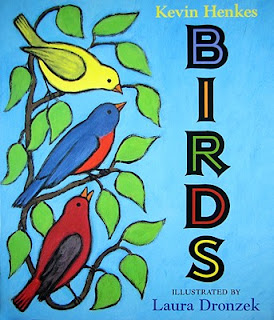Sheep in a Jeep by Nancy Shaw. This book just makes me laugh.
A group of very silly sheep take off on a quick adventure in a red jeep. Unfortunately, they forget to steer and "Jeep goes splash! Jeep goes thud! Jeep goes deep in gooey mud!"
Rhyming lines and hilarious colored pencil illustrations tell the story, keeping young listeners engaged and ready for the next page. The sheep are drawn with such expression! My favorite sheep in the bunch always has a knitting project in tow.
Careful, you may giggle as you read aloud.
Thankfully, Nancy Shaw has published several "sheep" stories since this original so the fun can continue. Check one out today!
Language Extension Idea:
Rhyming Chart
After reading the book through a couple times, ask the children if they heard any rhyming words.
On a piece of chart paper or white board, write the rhymes they can give you from memory. (sheep, jeep)
Go through the book page by page, letting the children stop you to write down the rhymes they hear.
Look at the list together when finished and point out the rhyming words that have the same ending.
Let the children use those ending sounds to make up new nonsense words as they play with initial letter sounds.
Add new words to the list and post it in your classroom. Refer to it as you read more of the Sheep books by Nance Shaw and keep growing your rhyming chart.
These games help young ears and eyes gain information about the reading process.
A group of very silly sheep take off on a quick adventure in a red jeep. Unfortunately, they forget to steer and "Jeep goes splash! Jeep goes thud! Jeep goes deep in gooey mud!"
Rhyming lines and hilarious colored pencil illustrations tell the story, keeping young listeners engaged and ready for the next page. The sheep are drawn with such expression! My favorite sheep in the bunch always has a knitting project in tow.
Careful, you may giggle as you read aloud.
Thankfully, Nancy Shaw has published several "sheep" stories since this original so the fun can continue. Check one out today!
Language Extension Idea:
Rhyming Chart
After reading the book through a couple times, ask the children if they heard any rhyming words.
On a piece of chart paper or white board, write the rhymes they can give you from memory. (sheep, jeep)
Go through the book page by page, letting the children stop you to write down the rhymes they hear.
Look at the list together when finished and point out the rhyming words that have the same ending.
Let the children use those ending sounds to make up new nonsense words as they play with initial letter sounds.
Add new words to the list and post it in your classroom. Refer to it as you read more of the Sheep books by Nance Shaw and keep growing your rhyming chart.
These games help young ears and eyes gain information about the reading process.





























